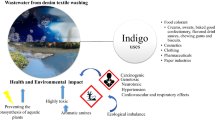Abstract
Synthetic solutions containing up to 2000 ppm of gallotannic acid and real wastewater from vegetal tanning processes with values of chemical oxygen demand (COD) exceeding 100 000 ppm were decontaminated by electrolysis using a sacrificial iron anode coupled to either a titanium-platinised or an O2-diffusion cathode. Experiments were performed in the presence of oxidants and oxidation promoters such as air, oxygen and hydrogen peroxide, the latter being directly added to the solution or electrogenerated by the O2-diffusion cathode. COD and UV-visible absorbance evolution showed that tannins are removed from electrolysed solutions down to relatively low values, permitting more than 94% elimination. Partial oxidation of the mother compound generates short-chain by-products (mostly carboxylic acids) responsible for the remaining low COD values. Contaminants (tannins and non-tannins) contained in industrial wastewater were removed by combining electroprecipitation with a Fenton-assisted process; a final oxidation step, carried out on a boron-doped diamond electrode, was performed in order to decrease the COD to very low final values.
Similar content being viewed by others
References
D. Besserer (1996) Leder 47 242
R.B. Chaudhary V.D. Bharti (1999) Asian J. Chem. 11 873
M. Clercq ParticleLe J. Plicht Particlevan der A.J. Meijer Harro (1998) Anal. Chim. Acta 370 19
G. Sekaran K. Chitra M. Mariappan K.V. Raghavan (1996) J. Environ. Sci. Health, Part A: Environ. Sci. Eng. Toxic Hazard. Subst. Control A31 579
K. Smiechowski M. Mendrycka (1997) Chem. Inz. Ekol. 4 427
A.G. Espantaleion J.A. Nieto A. Marsal (1997) AQEIC Bol. Tec. 48 169
X. Zhan A. Miyazaki Y. Nakano (2001) J. Chem. Eng. Japan 34 1204
V.P. Vinod T.S. Anirudhan (2002) J. Chem. Technol. Biotechnol. 77 92
E. Ravikumar G. Sekaran B. Arabindoo V. Murugesan (1998) Indian J. Environ. Prot. 18 655
B. Ye (1998) Gongye Shuichuli 18 43
B. Ram P.K. Bajpai H.K. Parwana (1997) Indian J. Environ. Prot. 17 175
M.A. Fonseca Almeida A.R. Rui Boaventura (1998) Waste Manag. 17 201
L. Etiegni M. Wakoli K. Ofosu-Asiedu (1999) Water Sci. Technol. 39 321
M.G. Zenaitis S.J.B. Duff (2002) Ozone: Sci. Eng. 24 83
J.C. Jochimsen H. Schenk M.R. Jekel W. Hegemann (1997) Water Sci. Technol. 36 209
K.J. Sreeram R. Gayatri J.R. Rao B.U. Nair T. Ramasami (1998) J. Sci. Ind. Res. 57 64
M. Sankar G. Sekaran S. Sadulla K.A. Shanmugasundaram M. Mariappan (1998) Ind. Environ. J. Prot. 18 206
S.J. Ali J.R. Rao B.U. Nair (2000) Green Chem. 2 298
J. Ch. Jochimsen, Fortschr.-Ber. VDI, Reihe 15, 190, i–xii (1997) 1
P. Dwibedy G.R. Dey D.B. Naik K. Kishore P.N. Moorthy (1999) Phys. Chem. Chem. Phys. 1 1915
K. Vijayaraghavan T.K. Ramanujam N. Balasubramanian (1998) J. Environ. Eng. (Reston, Va.) 124 887
X. Qu J. Zhou H. Yin Y. Sun Sh. Zhang (2002) Fenxi Huaxue 30 192
K. Nam W. Rodriguez J.J. Kukor (2001) Chemosphere 45 11 Occurrence Handle10.1016/S0045-6535(01)00051-0 Occurrence Handle1:CAS:528:DC%2BD3MXlsFymsb8%3D Occurrence Handle11572585
A.G. Vlyssides Cl. J. Israilides (1997) Environ. Pollut. 97 147
J. Naumczyk M. Wojtkowska (1996) Chem. Inz. Ekol. 3 481
B. Boye M.M. Dieng E. Brillas (2002) Electrochim. Acta 48 781
B. Boye M.M. Dieng E. Brillas (2003) J. Electroanal. Chem. 540 25
B. Boye M.M. Dieng E. Brillas (2003) J. Electrochem. Soc. 150 E148
A. Buso L. Balbo M. Giomo G. Farnia G. Sandonà (2000) Ind. Eng. Chem. Res. 39 494
E. Brillas E. Mur J. Casado (1996) J. Electrochem. Soc. 143 L49
E. Brillas J.C. Calpe J. Casado (2000) J. Water Res. 34 2253
Author information
Authors and Affiliations
Corresponding author
Rights and permissions
About this article
Cite this article
Boye, B., Farnia, G., Sandonà, G. et al. Removal of vegetal tannins from wastewater by electroprecipitation combinedwith electrogenerated Fenton oxidation. J Appl Electrochem 35, 369–374 (2005). https://doi.org/10.1007/s10800-005-0797-6
Received:
Accepted:
Issue Date:
DOI: https://doi.org/10.1007/s10800-005-0797-6




